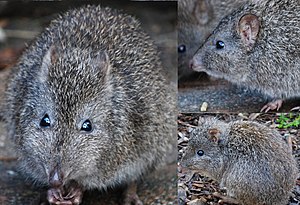Rabbit kangaroos
| Rabbit kangaroos | ||||||||||||
|---|---|---|---|---|---|---|---|---|---|---|---|---|

Potorous tridactylus in three views. |
||||||||||||
| Systematics | ||||||||||||
|
||||||||||||
| Scientific name | ||||||||||||
| Potorous | ||||||||||||
| Desmarest , 1804 |
The rabbit kangaroos ( Potorous ) - not to be confused with the hare kangaroos - are a genus of the marsupial mammals from the family of the rat kangaroos (Potoroidae). The genus includes four species, one of which is already extinct.
description
Rabbit kangaroos get their name from the rabbit-like way of life and locomotion. Their soft fur is gray or brown on the upper side, the underside is lighter, almost whitish. The ears are round, the muzzle rather elongated, and the relatively short hind legs are also characteristic. The animals reach a head body length of 24 to 41 centimeters, a tail length of 20 to 32 centimeters and a weight of 0.7 to 2.2 kilograms.
Distribution and way of life
Rabbit kangaroos used to be native to large parts of southern Australia , but have now been reduced to a fraction of their previous range. As a habitat, they need areas densely covered with vegetation, which can be forests as well as grasslands with bushes. They are nocturnal animals that seek shelter in small, self-dug pits during the day. These are mostly located under thick bushes, unlike other rat kangaroos they do not build complicated nests. At night they go in search of food, to get ahead more quickly they often lay out trails. They know two types of locomotion, a slow four-legged crawl, which they mainly use when searching for food, and a quick hop on their hind legs, for example when fleeing. They live solitary and territorial, the males defend their territory against other members of the sexes, but this can overlap with the territories of females.
The diet of the rabbit kangaroos consists mainly of mushrooms, but they also eat insects, grass and roots.
Rabbit kangaroos are kept in the European Association of Zoos and Aquariums (EAZA) in the Czech Republic, France, Denmark, Israel, the Netherlands, Poland and Great Britain. The last German rabbit kangaroos were in Magdeburg until 2008.
Reproduction
Females have a well-developed pouch with four teats. The animals can reproduce all year round, usually there are two births per year. After a gestation period of around 38 days, a single young is born. As with many rat kangaroos, their birth is delayed: Immediately after birth, the female mates again, but the newly created embryo only grows when the old young animal is weaned or dies. Young animals stay in their mother's pouch for around 130 to 150 days and reach sexual maturity at one to two years. Captured animals live up to twelve years old, life expectancy is lower in the wild.
threat
The main threats to the rabbit kangaroos include loss of habitat, food competition from introduced wild rabbits, and stalking by introduced predators such as red foxes and cats . One species is extinct, two are considered threatened, and only one is considered common.
The species
- The Gilbert rabbit kangaroo ( Potorous gilbertii ) is one of the most threatened species of marsupials. It is estimated that only around 50 individuals of this species live in a small area in southwestern Western Australia . Before the small population was discovered in 1994, there had been no sightings of this species for 80 years, so it was considered extinct. However, their survival is questionable. Some classifications classify P. gilbertii only as a subspecies of P. tridactylus .
- The long- footed potoroo ( Potorous longipes ) differs from the other rabbit kangaroos in that it has longer hind legs. Its habitat are moist forests in southeastern Australia, today it only occurs in three small, separate areas in northeastern Victoria and southeastern New South Wales . The species is, according to IUCN as threatened (endangered) .
- The broad-headed kangaroo ( Potorous platyops ) lived in southwestern Western Australia and differed from the other species by having a wider skull structure. This species became extinct around 1875.
- The long-snouted rabbit kangaroo ( Potorous tridactylus ) is characterized by its elongated snout and is the only species of rabbit kangaroo that is still relatively common. Their habitat are densely planted areas in southeastern Australia (southeastern Queensland , New South Wales, Victoria) and Tasmania . P. gilbertii (see above) is sometimes listed as a subspecies of P. tridactylus .
literature
- Ronald M. Nowak: Walker's Mammals of the World . Johns Hopkins University Press, 1999, ISBN 0-8018-5789-9 .
Web links
Individual evidence
- ↑ Holdings of the long-snouted rabbit kangaroo on Zootierliste.de, accessed on June 10, 2015.
